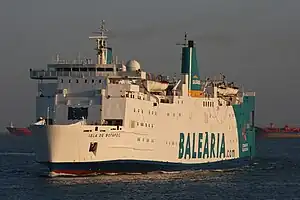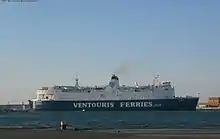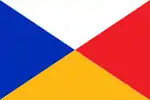MS Bari
The MS Bari was a ferry built in 1980 as the St Anselm[4] for Sealink. Starting life on the Dover-Calais, she operated with Ventouris Ferries in her last routes in the Mediterranean.
 Bari as Isla de Botafoc | |
| History | |
|---|---|
| Name |
|
| Operator |
|
| Port of registry | Limassol, |
| Builder | Harland & Wolff, Belfast |
| Yard number | 1715 |
| Launched | 5 December 1979[2] |
| Christened | 4 December 1979[2] |
| Completed | 1980 |
| Maiden voyage | 27 October 1980[3] |
| In service | 1980 |
| Out of service | 2021 |
| Identification | IMO number: 7813937[1] |
| Fate | Scrapped |
| General characteristics | |
| Tonnage | 12,705 gross register tons (GRT) |
| Length | 129.65 m (425.4 ft)[1] |
| Beam | 21.62 m (70.9 ft)[1] |
| Draught | 4.84 m (15.9 ft)[1] |
| Propulsion | 2xPielstick 16PC2[1] |
| Speed | 18 kn (33.3 km/h)[1] |
| Capacity | 1,125 passengers[1] |

Sealink
MS Bari started life as the St Anselm, order by and for Sealink services in the English Channel.[3] She was launched at the Harland & Wolff shipyard in Belfast[3] on 5 December 1979 and completed her maiden voyage on 27 October 1980.[3]
After two years in service, on 31 December 1982,[3] the St Anselm returned to Belfast for a £750,000 extension to her aft decks.[3] This extension provided an enlarged duty-free shopping area and additional accommodation, increasing her tonnage by 402 GT to 7,405 GT and her passenger capacity to 1,400.[3] On 28 March 1983 during her trip back to Dover through the Irish Sea, the St Anselm was temporarily brought into service on the Fishguard-Rosslare route following the failure of Stena Normandica's engines.[3]
In 1990, the St Anselm was displaced from the Dover-Calais route by Sealink's acquisition of the Fantasia, the St Anselm instead took up a service operating between Folkestone and Boulogne.[3] Not long after this transition, Sealink was acquired by Stena Line, in 1991 the St Anselm was transferred to Holyhead,[3] being renamed the Stena Cambria as a refit relief during February and March,[3] briefly returning to Dover before resuming service in the Irish Sea in July that same year.[3]
Stena Line
In July 1995, SNAT announced they would be terminating the pooling agreement that had been in place with Stena Sealink Line, which as a result, dropped the "Sealink" name, becoming just Stena Line. As a result of the loss of the two French vessels, Stena Line transferred the Stena Cambria and the Stena Empereur back to the Dover-Calais route for the 1996 season.[5] In March 1997 she provided refit relief in Stranraer and on 3 May 1997 became the last conventional ferry to sail out of Dun Laoghaire to Holyhead having provided overhaul relief for the Stena Explorer.[3] In March 1998 she transferred to the Newhaven-Dieppe route under the newly formed P&O Stena Line, staying there until the routes withdrawal in January 1999.[5]
Post P&O Stena Line
Following the routes withdrawal in January 1999, the Stena Cambria was laid up in Zeebrugge awaiting sale,[5] eventually being purchased by UMAFISA, entering service for them between Barcelona and Ibiza that November[5] as the Isla de Botafoc. In August 2003, UMAFISA and the Isla de Botafoc were acquired by rivals, Balearia.[5] She continued services with Balearia to Ibiza and Menorca[5] until her eventual sale to Ventouris Ferries of Greece in 2010, briefly being renamed Winner 9 and then to the Bari.[1]
References
Notes
- "M/F Bari". Ferry-site.dk. Retrieved 28 June 2010.
- "MS Stena Cambria Part One". HHVFerry.com. Retrieved 28 June 2010.
- "Stena Cambria". Sealink-Holyhead.com. Retrieved 28 June 2010.
- "Stena Cambria". SimplonPC.co.uk. Retrieved 28 June 2010.
- "MS Stena Cambria Part Two". HHVFerry.com. Retrieved 28 June 2010.
Bibliography
- Cowsill, Miles; Hendy, John (2006). The Saints go marching on: British Rail's Last Cross-Channel Ferries. Kilgetty, Pembrokeshire: Ferry Publications. ISBN 187194774X.
